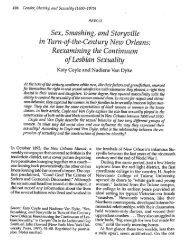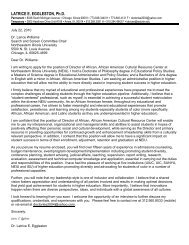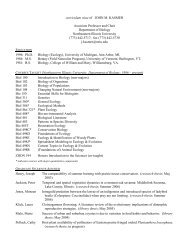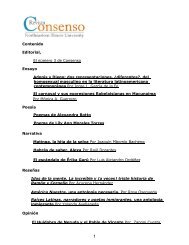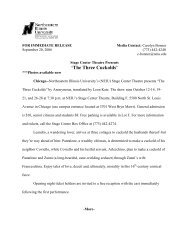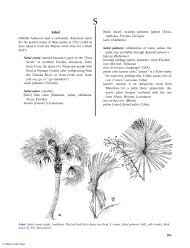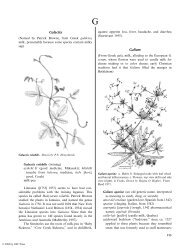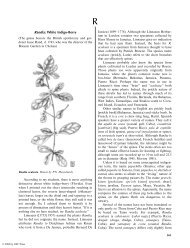Herba Cana - Northeastern Illinois University
Herba Cana - Northeastern Illinois University
Herba Cana - Northeastern Illinois University
Create successful ePaper yourself
Turn your PDF publications into a flip-book with our unique Google optimized e-Paper software.
© 2004 by CRC Press<br />
The Ethnobotany 485<br />
Pavonia<br />
(Antonio José Cavanilles named this for José Antonio<br />
Pavón y Jimenez, 1754 /1844, a Spanish explorer who<br />
toured Chile and Peru with Hipolito Ruiz López and<br />
Joseph Dombey)<br />
Pavonia paludicola (swamp-loving) ( /P. spicata)<br />
cadillo de ciénaga (marsh sticker, Puerto Rico)<br />
cotton (Belize); wild cotton (Belize)<br />
gombo-mangle (mangrove okra, Guadeloupe,<br />
Martinique)<br />
kayuwaballi (kayuwa, mahoe or Hibiscus tiliaceus,<br />
balli, resembling, Arawak, Suriname)<br />
mahot mangle [mare] (mangrove [ocean] fiber tree,<br />
Taino and French, Guadeloupe, Martinique);<br />
mahuat (fiber tree, Taino, French Antilles);<br />
majagüilla (little fiber tree, Hispanized Taino,<br />
Cuba, Hispaniola); smaller mahoe (Jamaica)<br />
mangrove mallow (Guadeloupe, Martinique)<br />
sunabao (Guadeloupe, Martinique)<br />
swamp bush (Bahamas, Puerto Rico)<br />
Pavonia was created in 1786 by the director of the<br />
botanical garden in Madrid, Cavanilles (1745 /1804).<br />
However, it was not until 1989 that Dan Nicolson and<br />
Paul Fryxell described P. paludicola from the Lesser<br />
Antilles. That species brought the genus to a total of<br />
150 species found in tropical and warm regions of the<br />
world (Mabberley 1997).<br />
In the French Antilles, the leaves are applied to<br />
inflammations, boils, and abscesses (Morton 1981). In<br />
Haiti, an infusion is gargled for tonsillitis. Taken<br />
regularly, it is laxative.<br />
Pectis<br />
(From Latin pecten, pectinis, a comb, referring to the<br />
bristles along the margins of the leaves or the papus)<br />
Pectis prostrata (lying flat)<br />
cominillo [tomillo] (little dwarf, Venezuela); comino<br />
de piedra [de sabana, rústico] (stone [savanna,<br />
wild] dwarf, Venezuela)<br />
contra-yerba (herb against, typically meaning that<br />
it can be used to treat any malady)<br />
hierba de gallina (chicken herb); hierba de chinche<br />
(bedbug herb)<br />
romero macho (wild [male] rosemary, Puerto Rico)<br />
tebenque [tebenki, tebink, theebink] (probably<br />
Taino, Cuba); tebink moge (probably Taino,<br />
Cuba?)<br />
zacato-coche (car grass; probably because it is<br />
common on roadsides)<br />
Pectis prostrata has been reported from a number<br />
of places in the Caribbean, but there are indications<br />
that those are misidentifications. For example, the<br />
Flora of Cuba reported the plants from Jamaica, but<br />
Adams (1972) could not verify that they had ever been<br />
there. Similarly, Morton (1981) recorded medical use<br />
in Puerto Rico, but Liogier and Martorell (1982) do<br />
not include the species. TROPICOS lists specimens<br />
from Texas, Mexico (Chiapas, Tabasco, Yucatán),<br />
Belize, Costa Rica, El Salvador, Guatemala, Honduras,<br />
Nicaragua, Panama, and Ecuador.<br />
Maybe the true distribution is less important for<br />
ethnobotanical comments because people often do not<br />
distinguish species. In Venezuela, for example, both P.<br />
ciliaris and P. prostrata have the same names (Pittier<br />
1926). Perhaps that is because the aromatic traits of<br />
both are similar.<br />
Pectis prostrata has been taken to stop diarrhea,<br />
dispel flatulence, as an emmenagogue, and for venereal<br />
diseases in Venezuela (Pittier 1926). In Jamaica and<br />
Puerto Rico, it is taken for colds and tuberculosis<br />
(Morton 1981). The species is used as a medicine in<br />
Belize (Balick et al. 2000). Hocking (1997) reported<br />
that it had been used to treat colds and tuberculosis, to<br />
expel flatulence, and as an emmenagogue.<br />
Pedicularis<br />
(Named from Latin pediculus, a louse, because Europeans<br />
believed that cattle or sheep feeding where P.<br />
palustris grew became covered with lice; also herba<br />
pedicularis, lousewort, because it was used to kill lice)<br />
kallgra˚s (kall, cold?, gra˚s, grass, Swedish)<br />
Läusekraut (louse herb, German)<br />
myrklegg (myr, bog,klegg, gadfly, Norwegian)<br />
pédiculaire (French); pediculare (Italian)<br />
riabhach (gray or grizzled, Gaelic)<br />
Pedicularis canadensis (of <strong>Cana</strong>da)<br />
beefsteak-plant (Long Island)<br />
betony [betong, beton lousewort, head-betony]<br />
(‘‘betony,’’ from Latin betonica, which Pliny,<br />
A.D. 23 /79, said was a Gaulish name; betonica,<br />
from vettonica, derived from Vettones, people of<br />
Lusitania, originally applied to Stachys officinalis,<br />
New York); wood-betony (‘‘wood’’ meaning<br />
growing wild, as opposed to the cultivated<br />
betony, Stachys officinalis)<br />
cagacka’ndawesoanûk (flying squirrel tail, Potawatomi)<br />
chickens’-heads (Long Island)





